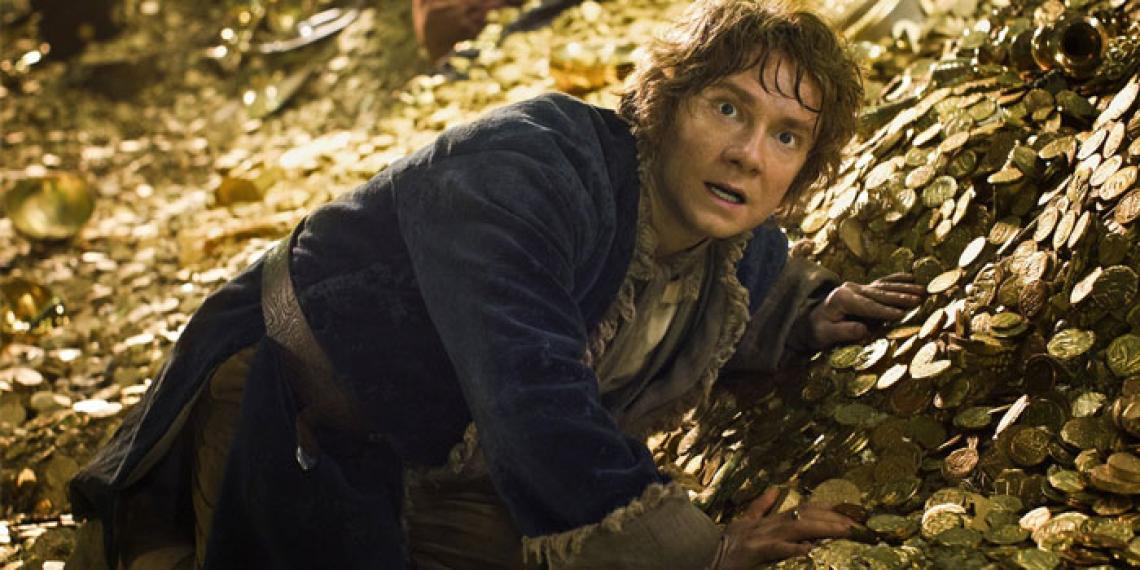You are here
Film review - The Hobbit: The Desolation of Smaug

With it being Christmas, yet again we return to Middle Earth courtesy of Sir Peter Jackson’s The Hobbit: The Desolation of Smaug.
As we arrive, we find Gandalf leading the hobbit Bilbo Baggins and the band of dwarves down from the Misty Mountains. Deep inside Mount Erebor lies the Arkenstone, a jewel that will give Thorin Oakenshield the right to lay claim to his title as Dwarf King of the Lonely Mountain and bestow its endless riches upon all the lands. But first they must face great peril in the dark forest of Mirkwood before ultimately facing the dragon Smaug. Smaug laid waste to Erebor decades before, and now sleeps within the Lonely Mountain, guarding its treasures and the all important Arkenstone.
It’s worth stating up front that this second instalment of The Hobbit trilogy is very enjoyable, mostly because it rattles along at a cracking pace right from the outset (no lengthy dwarf dinner times in this one). It rarely drags and is full of excellent action sequences (some of which are not for the faint hearted). However, it worth noting that while the first film had a lot of fun elements, The Desolation of Smaug is a lot darker, which reflects the growing threat of evil that we know comes to fruition in the Lord of The Rings.
Richard Armitage, excellent again as the alpha dwarf Oakenshield, is grimly intent on his destiny to reclaim his people's heritage and homeland, even if it means sacrificing friends along the way. While Armitage plays Thorin as a saturnine figure with a taste for war, some of the company of dwarves are this time around sidelined, with barely a moment to dwell on their interactions or characters. This is disappointing, given their character development in the first film.
Once again, Martin Freeman is hugely impressive as Bilbo. This time around, Bilbo has got some baggage of his own as the weight of carrying the One Ring starts to change him, at once giving him courage and also leading to uncertainty. Freeman doesn't shy away from letting the moods change on his face as well as indulging in some quite brilliant physical comedy.
However, the most memorable characters in the film is one Tolkien never even dreamed of: the female elf warrior Tauriel. Played by Evangeline Lilly (Lost), she’s a complete invention on Jackson’s part. The source of Legolas’ affection; though due to Elven king (and father to Legolas) Thranduil's cold disapproval, their love remains unrequited. Those feelings and subsequent action are further complicated when chemistry sparks between Tauriel and the dwarf Kili. Lily also shines as a warrior (she wreaks havoc on Orks), fuelled by courage and conviction, not reckless emotion. This subplot serves Legolas well, helping substantiate his established hatred of dwarves prior to his eventual friendship with Gimli in The Lord of the Rings. Overall, Tauriel fills a gaping, heart-shaped void at the centre of the film and lends it a touch of warm Arthurian romance.
The set pieces in this film are its biggest highlight. The pulse rate jumps up a notch when the dwarves enter the dark forest of Mirkwood. There, they are set upon and forced to battle with giant black spiders—arachnophobes or those of a nervous disposition will find this scene very uncomfortable. It’s soon followed by an exciting and improbable scene where Bilbo, Thorin and the dwarves escape from the Wood Elves' prison by hiding in barrels that are washed down the river. This gives us a head-spinning, arrow-filled battle with a near endless supply of enemies as orcs battle elves, dwarves and hobbit.
It comes as no surprise that the best set piece has been left till last as Bilbo comes face to face with the mighty Smaug. It’s a great climax, a narrative rhyme to his face-off with Gollum that concluded the last film.
Only when Smaug appears do you realise just how much you’ve been waiting to see him. Previously glimpsed in trailers and hinted at, this creature is a marvel of technology, a computer generated lizard that's as much a symbol of greed as it is a creature of cunning and deviousness. With Benedict Cumberbatch’s rich tones adding a sinister and slimy texture to the character, the scenes with Bilbo trying to charm the dragon while finding the Arkenstone are rich with menace and ooze impressiveness. This is yet another example of how Weta’s visual effects wizards are the very best in the world. Smaug is the most realistic, believable and impressive dragon you will ever see.
Overall, the film is very impressive. However, it does have a dark, almost gothic-like quality - and several scenes are most definitely not suitable for young children or those easily scared. On the plus side, it engages with many of Tolkien’s themes around good vs. evil, sacrifice, courage and humility. Visually, the landscapes and colours are as stunning as you would expect.
Then there is the finale with Smaug, which alone is worth the admission money. This leaves us with a cliff hanger that points directly to the last film in the trilogy, There and Back Again.
The Hobbit: The Desolation of Smaug
Genre: Action, Adventure, Fantasy
Director: Peter Jackson
Rating: M (violence)
Run time: 2 hours 41 mins